Servicios Personalizados
Revista
Articulo
Indicadores
-
 Citado por SciELO
Citado por SciELO -
 Accesos
Accesos
Links relacionados
-
 Similares en
SciELO
Similares en
SciELO
Compartir
Revista mexicana de ciencias agrícolas
versión impresa ISSN 2007-0934
Rev. Mex. Cienc. Agríc vol.8 no.4 Texcoco jun./jul. 2017
https://doi.org/10.29312/remexca.v8i4.3
Articles
Fruit quality of two mexican strawberry varieties and one introduced frigoconservated in high CO 2
1Campus Montecillo-Colegio de Postgraduados. Carretera México Texcoco, km 36.5. Montecillo, Texcoco, Estado de México. CP. 56230. Tel. 01(595) 9520233. (fernado.garcia@colpos.mx; danielareyes-4@hotmail.com; sergiocf@colpos.mx).
Recently in México, the Colegio de Postgraduados has generated strawberry varieties called “Jacona” and “Zamorana”. Due to its recent appearance, it is necessary to evaluate several factors, such as its postharvest behavior, which is useful for evaluation and quality conservation purposes, in relation to commercial varieties currently in use. The objective was to evaluate the physiological changes related to the senescence process of strawberry fruits stored in refrigeration and high concentrations of CO2. In order to do this, fruits were harvested at commercial maturity, then stored for 8 days with and without controlled atmosphere (15% CO2), there were 6 treatments as a result of the combination of variety factor (Festival, Jacona and Zamorana) and CO2 concentration (0.03 and 15%) in the atmosphere. After the cooling period, the variables determined were: pulp firmness (N), weight loss (%), external color (luminosity, saturation index or chroma and pitch angle), vitamin C, total soluble solids, pH, titratable acidity and ethanol and acetaldehyde concentration. A completely randomized design with factorial arrangement was applied and a mean comparison with Tukey’s tests (α= 0.05) was used to detect significant differences. The results showed that after exposing the fruits to an atmosphere with 0.03 or 15% CO2 for 8 days at 2 ±1 °C, the three varieties showed similar behavior in terms of weight loss, firmness, luminosity, tone angle, saturation index and total soluble solids. An atmosphere with 15% of CO2 maintained the vitamin C concentration in Mexican varieties during storage but it decreased in ‘Festival’, and caused an increase in the concentration of ethanol and acetaldehyde in the three studied varieties.
Keywords: Fragaria x annanasa Duch.; anaerobic metabolites; total soluble solids; vitamin C
Recientemente en México, el Colegio de Postgraduados ha generado variedades de fresa llamadas “Jacona” y “Zamorana”. Por su reciente aparición es necesario evaluar diversos factores entre ellos su comportamiento poscosecha, útil para fines de evaluación y conservación de calidad, respecto a las variedades comerciales actualmente más utilizadas. El objetivo fue evaluar los cambios fisiológicos relacionados con el proceso de senescencia de frutos de fresa almacenados en refrigeración y altas concentraciones de CO2. Para esto, se cosecharon frutos en estado de madurez comercial, se almacenaron en refrigeración por 8 días con y sin atmósfera controlada (15% de CO2), los tratamientos fueron 6, resultado de la combinación de factor variedad (Festival, Jacona y Zamorana) y concentración de CO2 (0.03 y 15%) en la atmósfera. Después del periodo de refrigeración, se determinaron las variables: firmeza de la pulpa (N), pérdida de peso (%), color externo (luminosidad, índice de saturación o croma y ángulo de tono), vitamina C, sólidos solubles totales, pH, acidez titulable y concentración de etanol y acetaldehído. Se aplicó un diseño al azar con arreglo factorial y se utilizó una comparación de medias con pruebas de Tukey (α= 0.05) para detectar diferencias significativas. Los resultados mostraron que después de exponerse los frutos a una atmósfera con 0.03 ó 15% de CO2 por 8 días a 2 ±1 °C, las tres variedades presentan similar comportamiento en cuanto a pérdida de peso, firmeza, luminosidad, ángulo de tono, índice de saturación y sólidos solubles totales. Una atmósfera con 15% de CO2 mantuvo la concentración de vitamina C en las variedades mexicanas durante el almacenamiento pero disminuyó en ‘Festival’, y ocasionó un aumento en la concentración de etanol y acetaldehído en las tres variedades estudiadas.
Palabras clave: Fragaria x annanasa Duch.; metabolitos anaerobios; sólidos solubles totales; vitamina C
Introduction
Strawberry production in México is estimated at 360 426 tonnes, which represents l7.9% of world production, placing it as the second largest producer after the United States of America (FAOSTAT, 2012), commercially, the exports level reaches 76 890 tonnes with a value of 142 053 million dollars (FAOSTAT, 2011), mainly as a fresh product.
Currently strawberry production in México is based on the varieties Festival, Sweet Charlie and Galaxia, among others, developed in the Universities of California and Florida, USA, all of them with specific characteristics in terms of yield, resistance to pests and diseases, production season and fruit quality. New varieties have been generated in México, some of which are under evaluation, both in protected and field conditions, with the objective of defining the characteristics of plant development and the requirements of production technology; it is also necessary to know the physiological and biochemical changes related to plant maturation and post-harvest senescence, in order to define crop indexes, quality patterns and response to technologies aiming to prolong shelf life.
Several factors, such as ripeness maturity, temperature, relative humidity, rot and physical damage incidence, favor the loss of commercial, nutritional and sensorial quality of strawberry fruits in an accelerated way (Pineli et al., 2011). The most commonly used strawberry harvest index is when the fruit takes a pink (– ripening) or a red (ripe-firm) color. Mitcham and Mitchell (2002) mention that the best state for the strawberry harvest is when the fruits have reached at least – red color in order to achieve a longer shelf life.
Among the technologies used to extend shelf life of this product are refrigeration in normal atmosphere (air) or with high concentrations of CO2. Regarding to this, it has been reported (Ayala-Zavala, 2004) that the conservation at 0 °C maintains the quality of strawberry fruits for 7-9 days, being a limitation the decay development by Botrytis cinerea and loss of antioxidant capacity (Peng et al., 2011). The use of CO2 enriched atmospheres (10-15% CO2) prolonged shelf life to 9-13 days (Pelayo et al., 2003) and preserved firmness, total soluble solids, pH and titratable acidity (Pelayo-Zaldívar et al., 2007). In contrast, Holcroft and Kader (1999a) report that high concentrations of CO2 negatively affect fruit color, anthocyanin concentration and the formation of fermentative metabolites leading to a change in taste (Pelayo-Zaldívar et al., 2007). The objective of this paper was to evaluate the effect of two concentrations of CO2 on the quality and shelf life of the fruit of two Mexican varieties of strawberry stored under refrigeration.
Materials and methods
For the experiment, plants of two varieties of Mexican strawberry denominated as Jacona and Zamorana obtained by the Program of Genetic Improvement of Fruit of the Colegio de Postgraduados in Agricultural Sciences, Campus Montecillo, México, as well as the Festival variety generated in the University of Florida, USA, taking it as a reference, and were produced under greenhouse conditions. In order to harvest the fruits, the – red state (standard: NMX-FF-062-SCFI-2002) was used as criterion, establishing six treatments in total with 40 fruits each, resulting from the combination of variety factor (Festival, Jacona and Zamorana) and CO2 concentration (0.03 and 15%) in the atmosphere, all stored for 8 days at 2 ±1 °C and 85-90% of relative humidity.
In order to establish the atmosphere with 15% of CO2 the Mixing Board UC-Davis gas mixing system and panels were used to maintain a flow of 184 mL min-1. At constant pressure; the gases for the mixture were air (0.03% CO2) and CO2 from a pressurized cylinder with 100% concentration. The gas entrainment system was complemented by placing the fruits in a total of 24 bottles (4/treatment), which were sealed and a continuous system was established. CO2 measurements were carried out using a temperature and CO2 recording equipment (TELAIRE brand, model 7001, manufactured in Goleta, California, USA) and data logger (HOBO brand, model U-12-012, manufactured in Bourne, Massachusetts, USA). The evaluated variables were: accumulated weight loss calculated based on the weight difference between the initial value and the corresponding value at the end of the evaluation period, expressing the data as percentage (%),pulp firmness using a Wagner Texturometer model FDV -30 with a metal base Chatillon, adapted with a 5 mm conical strut, reporting the data in Newtons (N); external color (measured at the maximum equatorial part of the fruit) was determined using a Hunter Lab colorimeter (Reston, Virginia, USA, model D-25), obtaining with the Lab-Hunter values the luminosity, pitch angle or °h (180 + tan-1 b/a) and saturation index or chroma (a2 + b2 )½ (Arias et al., 2000), total soluble solids (% SST).
Determined by a Atago digital refractometer model PR-100, with a scale of 0-32% according to the AOAC (1990) method, titratable acidity (% citric acid) and pH of the pulp were measured according to the methodologies described By AOAC (1990), ascorbic acid (vitamin C) determined according to the 2,6-dichlorophenol indophenol method described by AOAC (2000) and reported in mg 100 g-1, ethanol and acetaldehyde production (mg 100 g-1) by the method proposed by Davis and Chace (1969) using a Hewlett Packard gas chromatograph model 5890 II which operated at a 180 °C temperature in the flame ionization detector, furnace temperature of 150 °C isothermal and column Paraplot Q (25 m/0.22 nm internal diameter).
For the statistical analysis, a completely randomized design with factorial arrangement was applied and a means comparison with Tukey̕ s tests (α= 0.05) was used in order to detect significant differences between treatments. The measures of firmness, color and weight loss were performed in a sample composed of 10 replicates per treatment, being the experimental unit one fruit; for the rest of the variables the sample consisted of five replicates and the experimental sample of two fruits. Data were analyzed using the SAS® 9.0 statistical package (SAS, 2000).
Results and discussion
According to the results obtained (Table 1), after 8 days of storage at 2 ±1 °C, it was observed that both the variety factor and the CO2 concentration did not show significant differences, which indicated that, in terms of weight loss, the strawberry fruits of the three cultivars showed similar behavior when exposed to an atmosphere with 0.03% or 15% of CO2. It should be noted that the weight loss after the established storage period comprised from 1.49 to 2.49%, which did not provoke wilting symptoms, since this range was lower than the critical level of water loss for wilt damages of 6% reported by Robinson et al. (1975), obtained by the daily cumulative evaluation of these losses.
Table 1 Analysis of variance (p- value) in the main interaction effects of the variety and CO2 concentration, in the response variables studied.
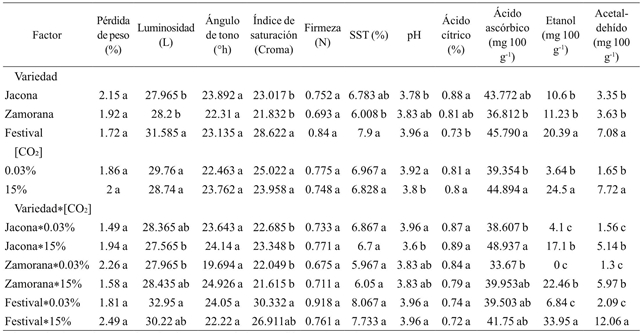
Valores en la misma columna con letras iguales no son estadísticamente diferentes (α= 0.01).
Regarding to the pulp firmness, no differences were observed due to the effect of the cultivar factors and CO2 concentration (Table 1), the determined values were between 0.675 to 0.918 N. However, in relation to the initial firmness value, Jacona and Zamorana showed significantly firmness loss over ʻFestivalʼ during storage (Figure 1), suggesting differences in cell wall metabolism resulting from the genetic improvement of this variety (Perkins, 1995; Jiménez-Bermúdez, 2002). It should be noted that Mexican varieties showed greater firmness (Figure 1) at the beginning of storage (Day 1) than the ʻFestivalʼ variety which, according to Gooding (1976), is indicative of greater resistance to both mechanical and by pathogens damages.
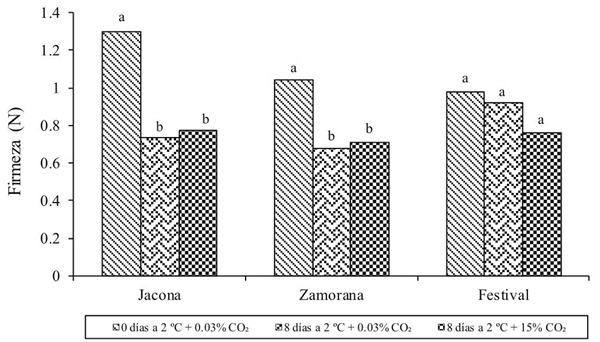
Figure 1 Results of the analysis of variance (p- value) for firmness variable, in fruits evaluated at the time of harvest and after the treatments. Means with the same letter are statistically the same (Tukey, p≤ 0.05).
As for the fruit color, after eight days of refrigeration at 2 ±1 °C, there were significant differences in the luminosity value due to the variety factor, being higher in ʻFestivalʼ (31.58), not showing differences by effect of the CO2 concentration within each variety (Table 1). Regarding to storage time inrelation to the initial value, the luminosity decreased significantly only in the Mexican varieties, independently of the CO2 concentration, which showed a slight darkening of the fruits (Figure 2). A similar response has been reported by Holcroft and Kader (1999a), who found that the luminosity of fruits of the Selva variety stored for 5 and 10 days at 5 °C decreased as the storage time advanced and were not affected by the concentration of CO2 (air and 20 kPa) in the surrounding atmosphere.
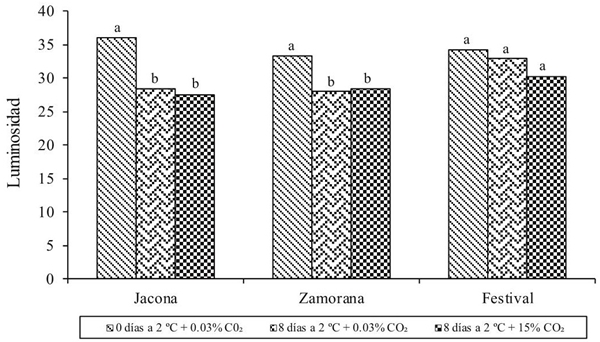
Figure 2 Results of the analysis of variance (p-value) for the color variable (luminosity), in fruits evaluated at the time of harvest and after treatments. Means with the same letter are statistically equal (Tukey, p≤ 0.05).
Regarding to the pitch angle color attribute (°h), it was observed that at the end of storage there were no significant differences due to the effect of the variety as well as the concentration of CO2; in addition, no significant differences were found in all 6 treatments (Table 1) resulting from combinations of the variety factors and CO2 concentration. Regarding the time of harvest, in the fruits of the three studied varieties, the value of the pitch angle (°h) decreased significantly after the storage period established (Figure 3), which was indicative of changes in the red tonality of The fruits, mainly due to the anthocyanins oxidation effect due to the senescence advance (Bodelon et al., 2010). As for the saturation index (Chroma), significant differences were also observed due to the variety factor, being higher in ʻFestivalʼ (Table 1).
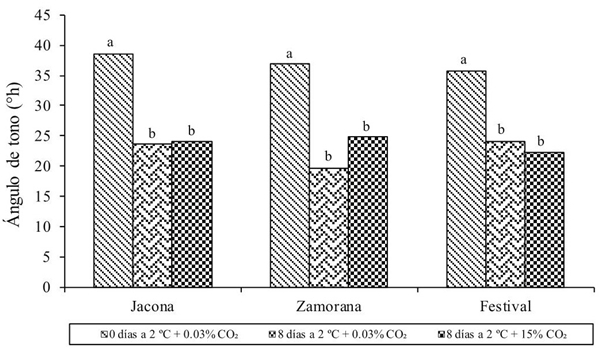
Figure 3 Results of the analysis of variance (p- value) for the color variable (pitch angle, °h), in fruits evaluated at harvest time and after treatments. Means with the same letter are statistically equal (Tukey, p≤ 0.05).
The results of the six treatments also showed that the fruits of the Festival variety exposed under normal atmosphere (0.03% of CO2) showed the highest chroma value (30.33), indicating an inferior progression of senescence. As regards storage time, there were no differences in the saturation index (Chroma) within each variety (Figure 4), a response that coincides with that reported by Holcroft and Kader (1999b) where there were no significant differences in the chroma value in fruits stored for 0, 5 and 10 days in a controlled atmosphere (20 kPa CO2) at 5 °C.
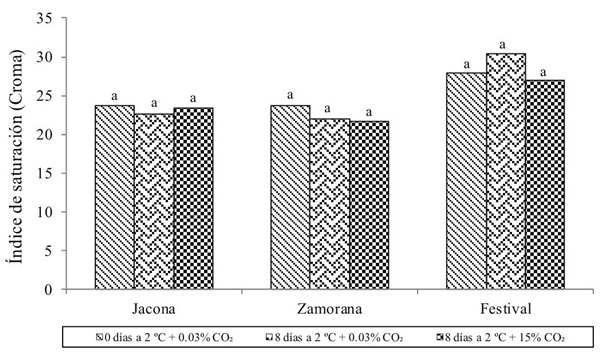
Figure 4 Results of the analysis of variance (p-value) for the color variable (saturation index or chroma), in fruits evaluated at the time of harvest and after treatments. Means with the same letter are statistically equal (Tukey, p≤ 0.05).
After 8 days of storage at 2 ±1 °C, the total soluble solids content (SST) showed significant differences due to the variety factor, being ʻFestivalʼ higher (7.9 °Brix) than ʻZamoranaʼ (6 °Brix) (Table 1). Gil et al. (1977) also observed that exposure in normal atmosphere (air) or under enriched atmospheres with concentrations of 10, 20 and 40% CO2 in strawberry fruits (Fragaria x ananassa cv. Selva) did not affect the content of SST. On the other hand, in relation to the storage time, within each variety, only a significant decrease of SST in ʻZamoranaʼ (Figure 5) was shown, suggesting a greater metabolic activity in this variety.

Figure 5 Results of the analysis of variance (p- value) for the total soluble solids (°Brix), in fruits evaluated at the time of harvest and after treatments. Means with the same letter are statistically equal (Tukey, p≤ 0.05).
The pH of the pulp after 8 days of storage at 2 ±1 °C, was significantly different for both the variety effect and CO2 concentration, being higher in ʻFestivalʼ, compared to ʻJaconaʼ, which coincided with a lower (0.73%) and higher (0.88%) citric acid content, respectively, also with significant differences. As for the treatment effect, in those fruits exposed to the atmosphere of 0.03% the pH was significantly higher than the treatment of 15% of CO2; however, the citric acid content was similar (Table 1), suggesting differences in the metabolism of organic acids when used as a respiratory substrate. Holcroft and Kader (1999a) reported that storage at 5 °C and CO2 concentration greater than 20 kPa increased the pH and decreased the titratable acidity in strawberry fruits of Selva variety while, the fruits exposed to a concentration of 10 kPa, showed increase in pH but the titratable acidity remained similar to the control (air), coinciding this behavior with the results obtained in the study for the three varieties studied. Based on the storage time, in the three varieties the pH tended to increase with respect to the initial value and only in the Zamorana variety, the citric acid content decreased significantly, which showed a different postharvest behavior of this variety in relation to ʻJaconaʼ and ʻFestivalʼ.
According to the results obtained in the concentration of ascorbic acid (vitamin C), there were significant differences due to the effect of the variety (Table 1), showing ʻFestivalʼthe highest concentration (45.79 mg 100 g-1), then Jacona (43.772 mg 100 g-1) and finally Zamorana (36.812 mg 100 g-1). On the other hand, CO2 treatment (15%) significantly maintained a higher content of this compound. No significant differences were observed in the interaction of the CO2 concentration and concentration factors; however, the fruits of the three varieties treated with 15% of CO2 compared to the fruits stored in normal atmosphere maintained a higher concentration of this vitamin, respectively, being 41.750 versus 39.503 mg 100 g-1 in ‘Festival’, 39.953 versus to 33.67 mg 100 g-1 in ‘Zamorana’ and 48.937 versus 38.607 mg 100 g-1 in ‘Jacona’ (Table 1).
Analysis by variety of ascorbic acid content (Figure 6) showed that ‘Jacona’ and ‘Zamorana’ did not show significant changes, relative to the initial value, due to storage conditions; but not in Festival which tended to decrease significantly, which supposes a tendency to lose ascorbic acid when senescence advanced by an effect of oxidation until dehydroascorbic acid. According to Lee and Kader (2000), vitamin C loss is influenced by factors such as variety and storage conditions, and this post-harvest vitamin C loss is reduced in fruits stored in atmospheres with 10% CO2.
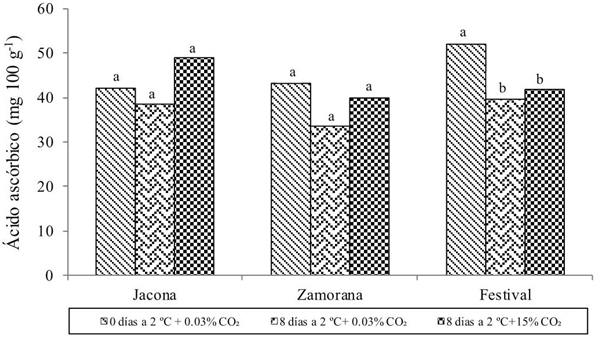
Figure 6 Results of the analysis of variance (p- value) for the variable ascorbic acid concentration, in fruits evaluated at the time of harvest and after treatments. Means with the same letter are statistically equal (Tukey, p≤ 0.05).
Regarding the ethanol and acetaldehyde contents, the results obtained after 8 days at 2 ±1 °C the fruits treated with 15% CO2 significantly increased the content of ethanol and acetaldehydes in the pulp (Table 1), being the Festival variety the most likely to accumulate these metabolites. The fruits with the highest content of ethanol and acetaldehydes were those of the Festival variety stored in controlled atmosphere (15% of CO2) with values of 33.95 and 12.06 mg 100 g-1, respectively (Table 1). The increase of fermentative metabolites has been reported in fruits stored at 5 °C and an atmosphere composed by air + 20 kPa CO2 in contrast to fruits stored at 5 °C and normal atmosphere (air), which do not present an increase (Pelayo et al., 2003). Larsen and Watkins (1995) reported values of 36.6 mg 100 g-1 of ethanol and 1.38 mg 100 g-1 of acetaldehyde in fruits treated with 20% CO2 for 12 days at 0 °C, these compounds showed a slight bad taste. Likewise, the fruits of Festival variety showed a slight aroma and characteristic flavor of fermentation after storage, which evidenced the induction of anaerobic respiration, a response that did not occur in fruits of the Jacona and Zamorana varieties.
Conclusions
The strawberry fruits of the three cultivars, after being exposed to an atmosphere with 0.03% or 15% CO2 for 8 days at 2 ±1 °C, showed similar behavior in terms of weight loss, firmness, luminosity, tone angle, saturation index and total soluble solids.
During storage, the fruits of the Mexican varieties Jacona and Zamorana showed greater firmness at the moment of harvest, but during the storage it shows more accelerated firmness losses with respect to ‘Festival’. On the other hand, the value of the tone angle of the three varieties decreases significantly, independently of the atmosphere type, which results in a different red tone than the initial one.
Storage at 0.03% or 15% CO2 for 8 days at 2 ± 1 °C increases the pH of the pulp, mainly in the ‘Festival’ variety, but there are no changes in citric acid content; regardless of the variety, fruits stored at a concentration of 15% of CO2 maintain a higher content of vitamin C than fruits stored with 0.03% (normal atmosphere).
After storage for 8 days at 2 ±1 °C, the concentration of ethanol and acetaldehyde increased significantly in those in fruits exposed 15% of CO2 compared to those stored in air (0.03% of CO2), the variety with the highest accumulation and perception of fermentative metabolites is Festival.
It is necessary to test other concentrations and periods of storage that allow to define the best option to maintain the quality of the Mexican varieties.
Literatura citada
AOAC (Association of official Analytical Chemists). 1990. Official methods of analysis. Fruits and fuits products. Kenneth (Ed), 15th. 3:1298. [ Links ]
AOAC (Association of official Analytical Chemists). 2000. Official methods of analysis (Method 967.22) Werwitz, W. (Ed). Method, 17th. 2:2200. [ Links ]
Ayala, Z. J. F.; Wang, S. Y.; Wang, C. Y. and González, A. G. A. 2004. Effect of storage temperatures on antioxidant capacity and aroma compounds in strawberry fruit. Swiss Society of Food Science and Technology. 37:687-695. [ Links ]
Bazant, J. 2010. Expansión urbana incontrolada y paradigmas de la planeación urbana. Espacio abierto. 19(3). [ Links ]
Bodelón, G. O.; Blanch, M. M. T.; Sánchez, B.; Escribano, M. I. and Merodio, C. 2010. The effects of high CO2 levels on anthocyanin composition, antioxidant activity and soluble sugar content of strawberries stored at low non-freezing temperature. Food Chem. 122:673-678. [ Links ]
Cordenunsi, B. R.; Nascimento, J. R. O. and Lajolo, F. M. 2003. Physico-chemical changes related to quality of five strawberry fruit cultivars during cool-storage. Food Chem. 83:167-173. [ Links ]
Deirdre, M. H. and Kader, A. A. 1999. Carbon dioxide-induced changes in color and anthocyanin synthesis of stored strawberry fruit. Hort Sci. 34(7):1244-1248. [ Links ]
FAOSTAT (Food and Agriculture Organization of the United Nations) (2012). Statistics production. http://faostat.fao.org/site/567. [ Links ]
FAOSTAT (Food and Agriculture Organization of the United Nations). 2011. Statistics export and import. http://faostat.fao.org/site/342. [ Links ]
Gil, M. I.; HolefoftI, D. M. and Kader, A. A. 1997. Changes in strawberry anthocyanins and other polyphenols in response to carbon dioxide treatments. J. Agric. Food Chem. 45(5):1662-1667. [ Links ]
Gooding, H. J. 1976. Resistence to mechanical injury and assessment of shelf life in fruits of strawberry (Fragaria*ananassa). Hortic. Res. 71-82. [ Links ]
Holcroft, D. M. and Kader, A. A. 1999a. Carbon dioxide-induced changes in color and anthocyanin synthesis of storage strawberry fruit. Hort Science. 34:1244-1248. [ Links ]
Holcroft, D. M. and Kader, A. A. 1999b. Controlled atmosphere-induced changes in pH and organic acid metabolism may affect color of stored strawberry fruit. Postharvest Biol. Technol. 17:19-32. [ Links ]
Jiménez, B. S.; Redondo, N. J.; Muñoz, B. J.; Caballero, L. J.; López A. J. M.; Valpuesta, V.; Pliego-Alfaro, F.; Quesada, M. A. and Mercado, J. A. 2002. Manipulation of strawberry fruit softing by antisense expression of a pectate lyasa gene. Plant Physiol. 128:251-259. [ Links ]
Larsen, M. and Watkins, C. B. 1995. Firmness and aroma composition of strawberries following short-term high carbon dioxide treatments. Hort Sci. 30(2):303-305. [ Links ]
Lee, S. K. and Kader, A. A. 2000. Preharvest and postharvest factors influencing vitamin C content of horticultural crops. Postharvest Biol. Technol. 20:207-220. [ Links ]
Mitcham, E. J. y Mitchell, F. G. 2002. Sistema de manejo poscosecha: frutas pequeñas. In: tecnología poscosecha de cultivos hortofrutícolas. Kader, A. A. Traducc. 2007. Postharvest Technology Research and Information Center. UC Davis- Department of Plant Sciences. 580 p. [ Links ]
Norma Mexicana. 2002. Productos alimenticios no industrializados para consumo humano -fruta fresca- fresa (Fragaria*ananassa, Dutch)- especificaciones y método de prueba. Diario Oficial de la Federación. NMX-FF-062-SCFI-2002. [ Links ]
Pelayo, Z. C.; Ebeler, S. E. and Kader, A. A. 2003. Postharvest life and flavor quality of three strawberry cultivars kept at 5 °C in air or air + 20 kPa CO2. Postharvest Biol. Tecnol. 27:171-183. [ Links ]
Pelayo, Z. C.; Jameleddine, B. A.; Susan, E. E. and Adel, A. K. 2007. Quality and chemical changes associated with flavor of Camarosa strawberries in response to a CO2 enriched atmosphere. HortSci. 42(2):299-303. [ Links ]
Peng, J.; Wang, S. Y.; Wang, C. Y. and Zheng, Y. 2011. Effect of cultural system and storage temperature on antioxidant capacity and phenolic in strawberries. Food Chem. 124:262-270. [ Links ]
Perkins, V. P. 1995. Growth and ripening of strawberry fruit. Horticulture Review. 17:267-297. [ Links ]
Pineli, L. O.; Moretti, C. L.; Santos dos, M. S.; Campos, A. B.; Brasileiro, A. V.; Cordova, A. C.; and Chiarello, M. D. 2011. Antioxidants and other chemical and physical characteristics of two strawberry cultivars at different ripeness stages. J. Food Compos. Anal. 24:11-16. [ Links ]
Robinson, J. E.; Browne, K. M. and Burton, W. G. 1975. Storage characteristics of some vegetables and soft fruits. Ann. Appl. Biol. 81:399-408. [ Links ]
SAS. 2000. The SAS system for Windows. Versión 9.0 SAS Inst. Cary, NC. USA. [ Links ]
Received: February 2017; Accepted: April 2017











 texto en
texto en 


